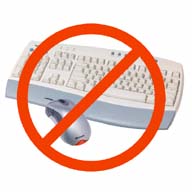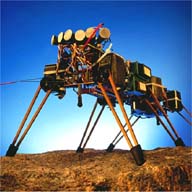
MAS 864 -- Tangible User Interfaces
Fall 2000
When people are asked to "draw a computer", they overwhelmingly draw a keyboard, mouse, and monitor. But these are not computers. These are interfaces to the computer.
This course leads us away from this paradigm and investigates the use of completely novel computer interfaces that are graspable, manipulatable, and ubiquitous. The course is also an excellent introduction to user interfaces.
The class begins with videos and papers of prior class projects that both inspire future work, and convince you that all the cool stuff has already been done. Yet we managed to pull together some pretty new and cool stuff that seemed much more than simply reheating half-baked ideas.
This course was instrumental in defining my thesis. The professor Hiroshi Ishii is one of my thesis readers.
Final
Project (Accepted as a short talk at CHI
2001)

MAS 940 -- Thesis Preparation
Fall 2000
The result of Thesis Prep is a thesis proposal, which is described above. It seems to be a Media Lab tradition to complain about this course. But not having an academic background, I found Thesis Prep to provide essential support in the process of writing a Media Lab thesis proposal.

6.836 -- Embodied Intelligence
Spring 1999
Taught by the increasingly famous Rodney Brooks, the nutty robot guy in the movie "Fast, Cheap, and out of Control". Rodney
believes the path to creating intelligent creatures is only by building actual physical creatures that respond to the complexity of the environment in which they must navigate. Take this course to hear some of Rodney's greatest hits, including:
- "Software simulations are doomed to succeed."
- "Consciousness is simply God's debugger."
- "Beware of second system syndrome."

MAS 965 -- Animal Cognition & Lessons for Adaptive Interactive
Characters
Spring 1999
Introduction to ethology and animal behavior. We read papers about dolphins, monkeys, birds, and others, and ponder the big questions such as what separates us from the animals.

MAS 863 -- How to Make Almost Anything
Fall 1999
This is a hugely popular Media Lab class. Introductions to various fabrication techniques including machining, injection molding, electronics, laser cutter, 3D printer, and various software design packages.
This course is a tremendous amount of work, especially for those of us from the software world. Unlike software, you cannot make backups of physical objects (at least not yet). If you break something, you can't roll back to the previous version. You have to start over. And if there's no more raw material, you can't start over.
This course forced me to learn a fundamentally more organized approach to engineering design. While "just coding it up" often works for software, when dealing with physical components that have to be purchased and usually sent through the mail, forgetting a key part leads to aggravating delays. Thinking the project through saves enormous amounts of time, and vastly reduces the temptation to make time-consuming compromises due to lack of parts.
Each topic in the class is worthy of a yearlong course. As a result, much time is spent overcoming fixed costs such as obtaining, installing, and licensing necessary design software. By the time you've figured out how to how to intersect two objects, the week is over.
The lessons from this class continue to percolate through my brain even a year after taking it.

6.837 -- Computer Graphics
Fall 1999
Basic introduction to high-performance computer graphics. We learned all the big CG ideas such as ray-tracing, scene graphs, shading models, lighting models, and texture mapping.
In addition to learning a computer graphics foundation, I used the final project as an opportunity to learn 3D
StudioMax.
home